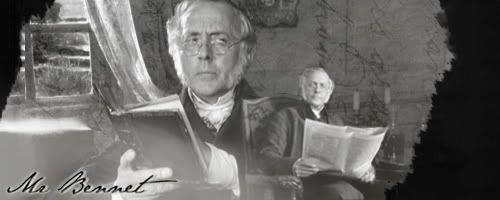Post by Mr Bennet on Aug 2, 2011 9:55:41 GMT
I am aware that some people may be confused about the Ranks of a person and how they should act, be referred to, etc. I have compiled a short introduction to Ranks here.
The peerage - Dukes, Marquesses, Earls, Viscounts and Barons - were above everyone else, including Baronets and Knights. A Bishop was ranked very high also.
The peers made up the House of Lords, and the reference to a "Lord" almost always refered to one of the Peers or one of his children. They were generally very wealthy and in possesion of large estates and much land. The title was hereditary, and was passed from father to son. If there was no male heir, the line and indeed the peerage ended.
However, if a female heir had a male child, that child could be passed the title.
When a woman married a peer she took his title.
Forms of address:
Your Majesty - King/Queen
Your Royal Highness - to the monarch's spouse, children and siblings.
Your Highness - to the nephews, nieces and cousins of the sovereign
Duke or Duchess - a duke or duchess if they were a member of nobility or gentry.
Your Grace - to a duke or duchess below the gentry or to an archbishop of the Church of England
My Lord - to a peer below the rank of duke and to a bishop
Lord - to address and earl, marquis, or viscount. An earl and Marquis were often of someplace, such as the Lord of Warwick, who simply became Lord Warwick. His wife would be referred to as Lady Warwick. Viscounts had no 'of' so were simply Viscont Whitton or the like.
Lady - to a marchioness, countess, viscountess, or baroness.
Sir - to a baronet or knight with his first name e.g Sir Thomes Bertram.
Baron - a judge of the court, or on formal occasions one of the peerage.
Lady - the wife of a knight or baronet. The female peerage were of the opinion that the wives of knights and baronets should
return to their own title of dame.
Books which may be of use: What jane Austen ate and Charles Dickens Knew - Daniel Pool
Jane Austen: The World of her Novels - Deirdre Le Faye
sources: D.Pool - What Jane Austen Ate and Charles Dickens Knew.
The peerage - Dukes, Marquesses, Earls, Viscounts and Barons - were above everyone else, including Baronets and Knights. A Bishop was ranked very high also.
The peers made up the House of Lords, and the reference to a "Lord" almost always refered to one of the Peers or one of his children. They were generally very wealthy and in possesion of large estates and much land. The title was hereditary, and was passed from father to son. If there was no male heir, the line and indeed the peerage ended.
However, if a female heir had a male child, that child could be passed the title.
When a woman married a peer she took his title.
Forms of address:
Your Majesty - King/Queen
Your Royal Highness - to the monarch's spouse, children and siblings.
Your Highness - to the nephews, nieces and cousins of the sovereign
Duke or Duchess - a duke or duchess if they were a member of nobility or gentry.
Your Grace - to a duke or duchess below the gentry or to an archbishop of the Church of England
My Lord - to a peer below the rank of duke and to a bishop
Lord - to address and earl, marquis, or viscount. An earl and Marquis were often of someplace, such as the Lord of Warwick, who simply became Lord Warwick. His wife would be referred to as Lady Warwick. Viscounts had no 'of' so were simply Viscont Whitton or the like.
Lady - to a marchioness, countess, viscountess, or baroness.
Sir - to a baronet or knight with his first name e.g Sir Thomes Bertram.
Baron - a judge of the court, or on formal occasions one of the peerage.
Lady - the wife of a knight or baronet. The female peerage were of the opinion that the wives of knights and baronets should
return to their own title of dame.
Books which may be of use: What jane Austen ate and Charles Dickens Knew - Daniel Pool
Jane Austen: The World of her Novels - Deirdre Le Faye
sources: D.Pool - What Jane Austen Ate and Charles Dickens Knew.

